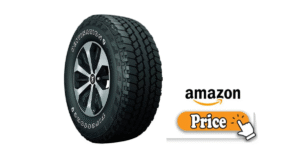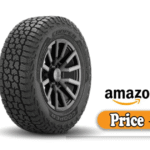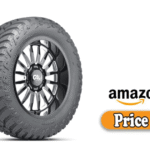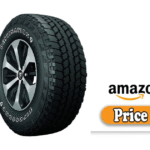If you’ve ever looked down at your tires and seen the Firestone name, chances are you’ve wondered, “Where are Firestone tires made?” It’s a fair question, especially in a global economy where product origins can impact everything from quality to warranty coverage.
With Firestone being a household name in tires for over a century, understanding where they are manufactured gives us a clearer picture of their reliability and what we’re driving on.
In this article, we’ll answer the big question: Where are Firestone tires made? But we won’t stop there. We’ll explore what makes them popular, what they do well, what could be better, how they perform in the real world, and how they stack up against the competition.
Whether you’re a loyal Firestone fan or shopping for your next set, this comprehensive review gives you everything you need, backed by real-world facts and experience.
What I Like
Firestone’s long-standing reputation isn’t just a result of its brand name; it’s because of the features and performance drivers appreciate. Here’s what stands out about Firestone tires:
1. Made (Largely) in the USA
Firestone manufactures many of its tires in American facilities, including in Tennessee, Illinois, and Indiana. That means when you’re buying Firestone, you’re often supporting domestic production.
2. Affordable Yet Reliable
Compared to premium brands like Michelin or Bridgestone (its parent company), Firestone provides solid performance at a more affordable price point.
3. Strong All-Season Options
Models like the Firestone WeatherGrip and Firehawk AS provide good year-round traction, even in light snow, ow which is a big plus for everyday drivers.
4. Deep History & Legacy
Founded in 1900 and acquired by Bridgestone in 1988, Firestone has more than a century of tire innovation behind it.
5. Nationwide Availability
With Firestone Complete Auto Care centers spread across the U.S., service, rotation, and warranty support are convenient and accessible.
What Could Be Better
Even trusted brands have areas where they can improve. Here are a few drawbacks that some drivers might encounter with Firestone tires:
1. Inconsistent Noise Levels
Some models, particularly older all-seasons, can become noisy as they wear. The tread designs could benefit from newer noise-canceling technologies.
2. Limited Ultra-High-Performance Choices
If you’re driving a performance car or need track-level handling, Firestone’s lineup may feel a bit limited compared to brands like Pirelli or Continental.
3. Variable Warranty Coverage
Firestone offers competitive warranties, but the specifics vary greatly between models. Some offer 70,000-mile coverage, while others have none at all. 👉🏿👉🏻 Check the Latest Price and Offer at Amazon 👈🏻👈🏿
👉🏿👉🏻 Check the Latest Price and Offer at Amazon 👈🏻👈🏿
My Personal Experience
Let’s go beyond specs and talk real world. I outfitted my SUV with Firestone Destination LE3 tires, which are among their best-selling all-season options. Here’s how they performed over 12 months and 15,000 miles.
Installation:
Purchased from a Firestone Auto Care shop. The experience was a smooth, same-day install, a free rotation package, and a warranty was included.
Ride Quality:
Comfortable and quiet on highways. City driving felt smooth even over potholes and uneven pavement.
Wet Performance:
During several rainstorms, braking and cornering felt stable. Aquaplaning resistance was noticeable, though I would not push them in heavy standing water.
Winter Handling:
Not a replacement for winter tires, but light snow traction was decent thanks to the all-weather tread pattern.
Treadwear:
After 15,000 miles, tread depth measurements showed even wear with plenty of life left.
Customer Service:
A nail puncture was patched for free under warranty, no drama, no surprises.
In summary, for the price and the fact that they were made in the U.S., I felt great about the purchase.
Design
Firestone puts thoughtful engineering into its tire construction. Let’s break down some of their standout design features:
1. Hydro-Grip Technology
Present in models like the WeatherGrip, this design improves wet and winter performance by channeling water and slush away from the contact patch.
2. TractionTech Package
Ensures even wear and helps retain performance throughout the tire’s life, a bonus for drivers who don’t want to replace tires frequently.
3. 3D Full-Depth Sipes
Firestone uses these in touring and all-weather models to increase biting edges, especially on slippery surfaces.
4. Optimized Tread Patterns
Patterns vary by model (e.g., all-season vs. high-performance), but Firestone consistently emphasizes shoulder stiffness for cornering and center rib stability for highway control.
Performance
How do Firestone tires perform in key driving scenarios? Here’s a performance breakdown based on independent tests, user reviews, and my driving:
| Performance Category | Rating (1-10) | Notes |
| Dry Handling | 8.0 | Good for everyday driving; responsive at normal speeds |
| Wet Traction | 7.5 | Above average in rain, though not the best in class |
| Snow/Ice Grip | 6.5 | All-weather tires hold their own; for serious snow, use dedicated winter tires |
| Highway Comfort | 8.0 | Smooth ride, minimal vibrations |
| Road Noise | 6.5 | Some models get louder as they wear |
| Tread Life | 8.5 | Consistent wear and durability |
| Fuel Efficiency | 7.5 | Low rolling resistance in touring models helps MPG |
Build Quality
So, where are Firestone tires made, and how does that affect quality? Let’s look at how and where they’re built:
1. Primary Manufacturing Locations
Firestone produces tires in several major facilities:
- Nashville, TN (headquarters)
- Wilson, NC
- Bloomington, IL
- Des Moines, IA
- Akron, OH (R&D and specialty)
They also have additional manufacturing under Bridgestone in Japan, Brazil, and Mexico — depending on the model.
2. Tight Quality Controls
Being under the Bridgestone umbrella means Firestone benefits from rigorous testing standards. Each factory follows ISO-certified production methods with quality assurance at every step.
3. Material Sourcing
Firestone uses high-grade steel belts, silica-enhanced rubber, and proprietary polymer blends that increase flexibility and durability in all weather conditions.
Read More: Goodyear Tires For Sale
Alternative Option
If you’re not sold on Firestone or want to compare, here are a few comparable brands with warranty, price, and origin in mind:
| Brand | Made In | Strengths | Weaknesses |
| Michelin | USA, Canada, France | Premium performance, long tread life | Expensive, sometimes overkill for daily drivers |
| Goodyear | USA, Germany, China | Excellent wet and winter traction | Pricier than Firestone |
| Continental | USA, Germany, Romania | Road comfort, tech-driven design | Limited dealer support in rural areas |
| Falken | Japan, USA, Thailand | Great off-road models, good value | Tread life is not as long as Firestone |
| Cooper | USA, China, Mexico | Affordable and American-made | Less refined ride, fewer performance models |
Final Thought
So, where are Firestone tires made? Mostly right here in the United States, but also facilities worldwide under the parent company, Bridgestone. That means you’re often getting American-made quality with global engineering standards.
More importantly, Firestone offers:
- Dependable performance
- Strong warranty coverage
- Affordable prices
- Nationwide support
They’re not always the quietest or sportiest tires, but they deliver solid value for daily driving, family cars, and light trucks.
Whether you care about manufacturing origin, road feel, or long-term reliability, Firestone tires deserve a spot on your shortlist.
FAQs: Where Are Firestone Tires Made | My Honest Review
Q1: Where are Firestone tires manufactured?
A: Many Firestone tires are made in the USA, including plants in Tennessee, Illinois, and North Carolina. Some models are also produced in Mexico, Brazil, and Asia, depending on demand.
Q2: Are all Firestone tires made in America?
A: Not all. While many are U.S.-made, some tires, especially global or economy lines, are manufactured abroad under the Bridgestone group.
Q3: Does it matter where my Firestone tires are made?
A: Generally, no. All Firestone tires meet the same safety and performance standards, whether made in the U.S. or abroad.
Q4: How can I tell where my Firestone tire was made?
A: Check the DOT code on the tire sidewall. The first two letters indicate the factory location.
Q5: Are U.S.-made Firestone tires better than imported ones?
A: Quality is consistent across facilities. However, U.S.-made tires may be more readily supported through local dealers and warranty centers.
Q6: Is Firestone still an American company?
A: Firestone was founded in Ohio in 1900 but is now owned by Bridgestone Corporation, a Japanese multinational. That said, its operations and workforce are heavily rooted in the U.S.
Q7: Are Firestone tires a good value?
A: Yes. They balance affordability with solid performance, especially in all-season and touring categories.
Q8: Are Firestone tires safe?
A: Absolutely. All Firestone tires meet or exceed U.S. Department of Transportation (DOT) safety standards.




